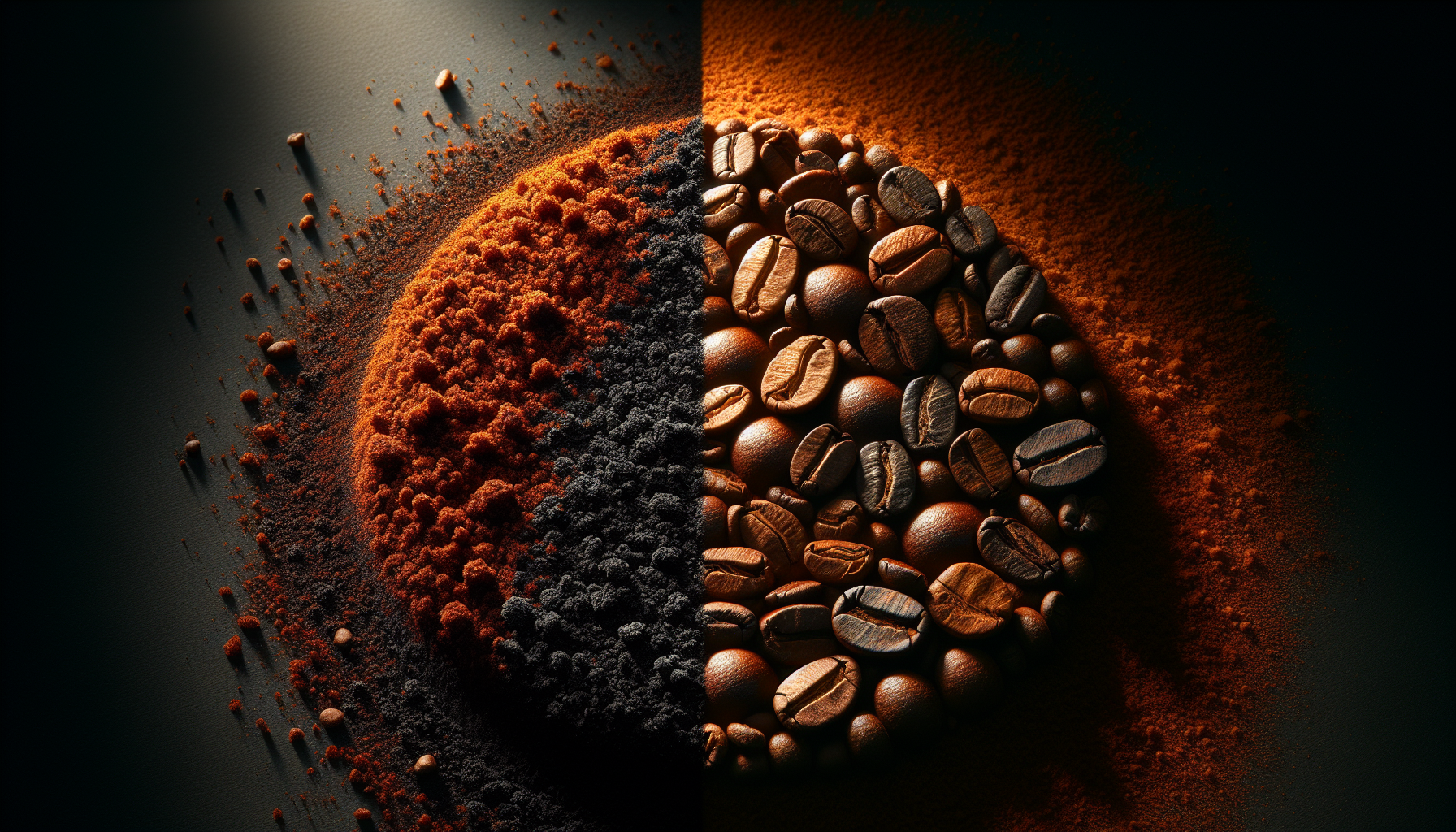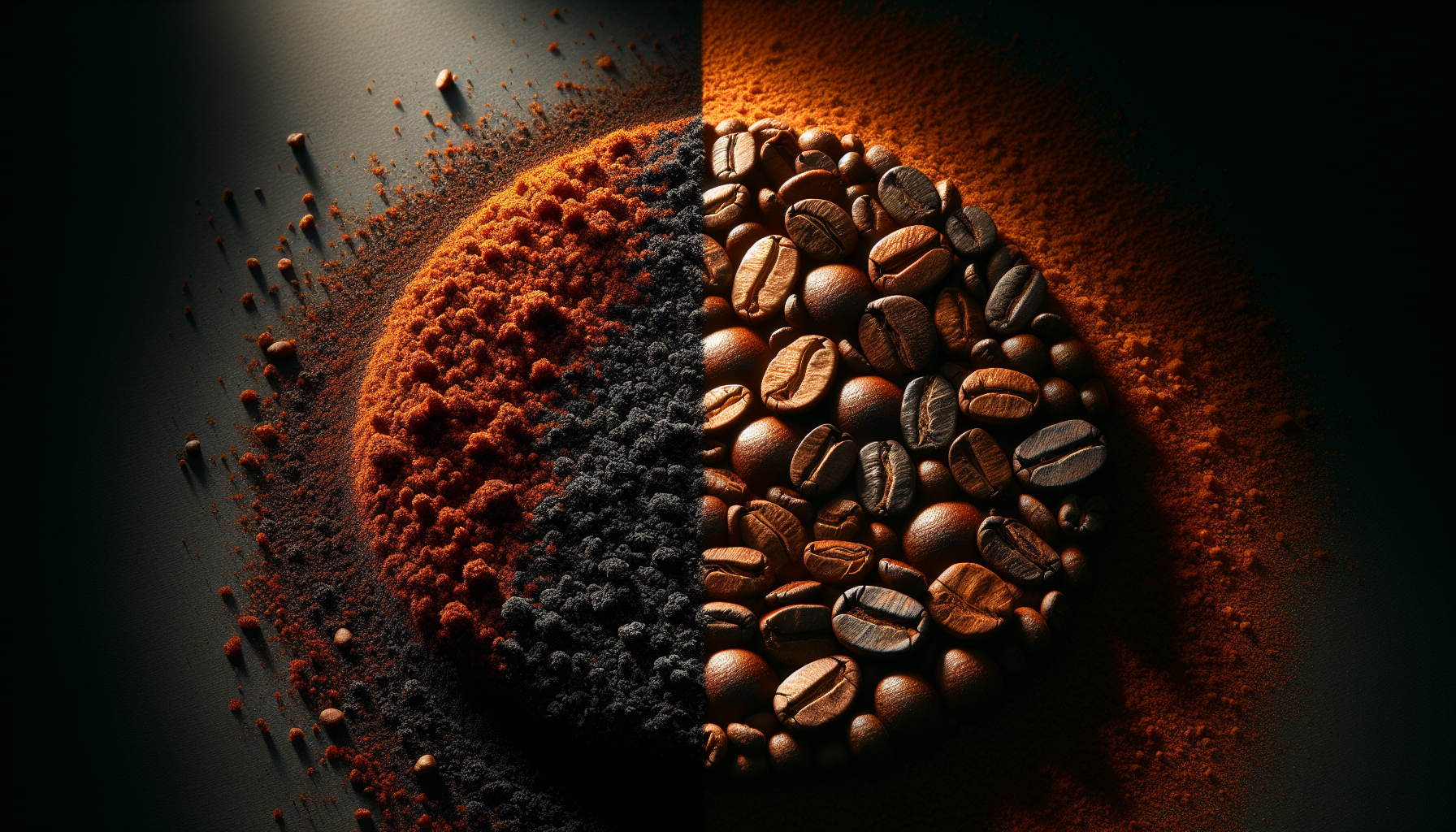Have you ever wondered if espresso grounds are the same as regular coffee grounds? It’s a question that many coffee enthusiasts ponder as they navigate the world of brewing methods and flavors. While both espresso and coffee come from the same source – coffee beans – there are subtle differences in the grounds that can greatly impact the taste and brewing process. In this article, we’ll explore whether espresso grounds and coffee grounds are truly the same or if there’s more than meets the eye in your morning cup of Joe. So grab a fresh brew and let’s find out!

CHECK OUT ESPRESSO MACHINES ON AMAZON
Understanding Espresso Grounds and Coffee Grounds
Espresso and coffee are both beloved beverages that have their own unique qualities and brewing processes. While they both start with ground coffee beans, there are distinct differences in the grinding methods, roast variations, blend composition, caffeine content, brewing methods, serving and consumption, culinary applications, and common misconceptions associated with espresso and coffee grounds. Let’s delve into each aspect to gain a comprehensive understanding of espresso grounds and coffee grounds.
Defining Espresso and Coffee
Espresso is a concentrated and bold coffee beverage that is brewed by forcing hot water through finely ground coffee beans under high pressure. It is typically served in small shot sizes and is known for its rich, intense flavor and velvety crema layer on top. On the other hand, coffee refers to the more traditional brewed beverage that is prepared by steeping coarser coffee grounds in hot water. It is often served in larger quantities and can have a wide range of flavors and strengths depending on the brewing method and the type of beans used.
The Process of Brewing Espresso
Brewing espresso can be considered a precise art form that requires specialized equipment and techniques. The process starts by finely grinding the coffee beans to a consistency similar to powdered sugar. The ground coffee is then densely packed into a porta-filter, which is a metal basket that fits into the espresso machine. Hot water is then forced through the grounds at approximately nine bars of pressure, extracting the flavors and oils from the beans. The result is a concentrated shot of espresso, which can be enjoyed as is or used as a base for various espresso-based beverages.
The Brewing Process for Coffee
Compared to the intricate process of brewing espresso, making coffee is relatively simpler. The brewing process for coffee involves placing coarser coffee grounds in a filter and pouring hot water over them. The water slowly seeps through the grounds, extracting the flavors as it passes through. The resulting brew is collected in a pot or carafe and is ready to be served. Different brewing methods, such as drip coffee makers, pour-over, French press, and Moka pots, can yield varying strengths and flavors, providing coffee enthusiasts with a wide range of options to suit their preferences.
Differences in Grinding Methods
The grind size and consistency play a significant role in the extraction process and ultimately the taste and quality of both espresso and coffee. In the case of espresso, the beans need to be ground into a very fine consistency to provide enough surface area for extraction under the high pressure of an espresso machine. This fine grind ensures a shorter brewing time and a concentrated flavor profile. For coffee brewing, a coarser grind is preferred to allow for a slower extraction process, resulting in a more nuanced and balanced cup of coffee.
Burr Grinders vs Blade Grinders
When it comes to grinding coffee beans, the choice of grinder can greatly affect the outcome. Burr grinders are often recommended for both espresso and coffee brewing due to their ability to produce a consistent grind size. These grinders use two abrasive surfaces (burrs) to crush the beans into uniform particles. On the other hand, blade grinders utilize spinning blades to chop the beans, which can lead to uneven grinding and variations in particle size. The inconsistency in grind size can impact the extraction process and result in an uneven flavor profile.
Impact on Extraction and Taste
The grinding method and the resulting grind size have a direct impact on the extraction process and, consequently, the taste of the final beverage. In espresso brewing, a fine grind allows for higher extraction rates, resulting in intense flavors and a thick, syrupy body. However, if the grind is too fine, it can lead to over-extraction, resulting in a bitter taste. On the other hand, in coffee brewing, a coarser grind allows for a slower extraction, resulting in a milder and more balanced flavor profile. However, if the grind is too coarse, it can lead to under-extraction and a weak, watery brew.
Roasting Variations
Roasting is a crucial step in coffee production that greatly influences the flavor, aroma, and body of the final product. The variation in roast levels between espresso and coffee can create distinct flavor profiles that cater to different preferences.
Roast Levels for Espresso
Espresso beans are typically roasted to a medium to dark level. This roasting profile brings out the rich, bold flavors that are desired in espresso, while also developing the oils that contribute to the velvety crema. The dark roast enhances the body and sweetness of the coffee, providing a robust and intense flavor profile.
Roast Levels for Coffee
Coffee beans, on the other hand, can be roasted to a wide range of levels, including light, medium, and dark. Light roasts preserve the delicate flavors and acidic qualities of the coffee, resulting in a bright and vibrant cup. Medium roasts strike a balance between acidity and sweetness, offering a versatile flavor profile. Dark roasts, commonly associated with coffee brewing, bring out bolder, smokier flavors and a fuller body.
Effect on Flavors and Aromas
The roast level of the beans directly affects the flavors and aromas present in both espresso and coffee. For espresso, the rich, caramelized sugars and the dark roast contribute to a bittersweet taste with notes of chocolate, nuts, and caramel. Additionally, the roasting process enhances the aroma, producing enticing scents like toasted nuts and dark chocolate. In contrast, coffee’s flavors and aromas can vary greatly depending on the roast level. Light roasts often exhibit floral and citrusy notes, while medium roasts showcase a balance of acidity, sweetness, and complexity. Dark roasts offer smoky and earthy flavors with a more pronounced body.
Blend Composition
The composition of the coffee blend can greatly impact the overall flavor profile and characteristics of both espresso and coffee. Two key considerations include single-origin vs. blend and the role of Robusta beans.
Single Origin vs. Blend
Single-origin beans come from a specific region or farm, offering a unique flavor profile that reflects the terroir and growing conditions of that particular area. Single-origin coffees are often celebrated for their distinct flavors and the opportunity to explore the nuances of different coffee-growing regions. In contrast, coffee blends combine beans from multiple origins to create a desired flavor profile. Blends can be carefully crafted to achieve a balanced and consistent taste, incorporating different beans with complementary flavors.
The Role of Robusta
Robusta beans, a species of coffee, are often included in espresso blends to add body and crema. While Arabica beans are prized for their complex flavors and acidity, Robusta beans bring a distinct earthy and bitter taste to espresso blends. Additionally, Robusta beans contain a higher caffeine content and have a higher resistance to pests and diseases, making them a more cost-effective choice for coffee producers.
Flavor Profiles and Acidity
The composition of the blend greatly impacts the flavor profiles and acidity of both espresso and coffee. Single-origin beans can offer a range of flavor profiles, such as fruity, floral, or nutty, depending on the region and growing conditions. Coffee blends, through a carefully curated selection of beans, aim to achieve a balanced flavor profile that combines sweetness, acidity, and body. The acidity in coffee refers to the brightness and liveliness present in the cup. Higher acidity is often associated with citrusy or fruity notes, while lower acidity presents a smoother, more mellow taste.
Caffeine Content
For many coffee lovers, the caffeine content is an important consideration when choosing between espresso and coffee.
Comparing Caffeine in Espresso and Coffee
Contrary to popular belief, espresso is not inherently more caffeinated than regular coffee. While espresso shots are more concentrated, they are typically served in much smaller quantities compared to a cup of coffee. The caffeine content per serving size can vary depending on factors such as the type of beans used, the brewing method, and the serving size. However, on average, a shot of espresso contains about 63 milligrams of caffeine, while an 8-ounce cup of coffee contains approximately 95 milligrams.
Serving Sizes and Concentration
The difference in caffeine content between espresso and coffee can be attributed to the serving sizes and concentrations. Espresso shots are typically served in 1-ounce or 2-ounce servings, while coffee is typically served in larger cup sizes ranging from 8 to 16 ounces. This difference in serving sizes leads to a lower overall caffeine content in a single shot of espresso compared to a full cup of coffee. However, the concentrated nature of espresso means that its caffeine is absorbed more quickly by the body.
Impact on Energy Levels
The impact of caffeine on energy levels can vary from person to person, depending on factors such as tolerance, sensitivity, and metabolism. Generally, the caffeine in both espresso and coffee can provide a boost in energy, alertness, and focus. However, due to the higher concentration of caffeine in a smaller serving size, espresso shots may offer a quicker and more intense burst of energy. Coffee, with its larger serving sizes and milder caffeine content, may provide a more sustained energy boost over a longer period of time.
Brewing Methods
The brewing method plays a significant role in shaping the flavors, strengths, and overall experience of both espresso and coffee.
Espresso Machines
Espresso machines are specially designed to deliver the high pressure and precise temperature needed to extract the flavors from finely ground coffee. There are different types of espresso machines available, including manual, semi-automatic, and fully automatic machines. These machines vary in terms of the control the user has over the brewing process and the level of convenience they offer. Espresso machines allow for a quick and efficient brewing process, resulting in a rich and concentrated shot of espresso with a desirable crema layer.
Moka Pots and Stovetop Espresso
Moka pots, also known as stovetop espresso makers, offer a more traditional and accessible way to brew espresso-like coffee at home. These pots work by using steam pressure to force water through the coffee grounds, resulting in a strong and flavorful brew. While the pressure achieved by moka pots is not as high as that of espresso machines, they still offer a concentrated coffee with a robust flavor profile.
Drip Coffee Makers and Pour-Over
Drip coffee makers and pour-over methods are popular choices when brewing traditional coffee. Drip coffee makers automate the brewing process, allowing for a convenient way to make coffee in larger quantities. The water drips onto the coffee grounds in a filter, extracting the flavors as it passes through. Pour-over methods, on the other hand, involve manually pouring hot water over the coffee grounds in a controlled and consistent manner, allowing for greater control over the brewing process. Both methods offer a more gentle and gradual extraction, resulting in a well-balanced cup of coffee with varying levels of strength and complexity.
Serving and Consumption Differences
The way espresso and coffee are served and consumed can vary due to their unique characteristics and cultural traditions.
Espresso Shots
Espresso shots are traditionally enjoyed in small, concentrated servings. They are often served in demitasse cups or shot glasses and are meant to be consumed quickly, allowing the rich flavors and aromas to be fully experienced. Some individuals may prefer to savor the shot slowly, while others prefer to drink it in one swift motion. Espresso shots are commonly consumed as standalone beverages, but they also serve as a base for various coffee-based drinks like cappuccinos, lattes, and macchiatos.
The Preparation of Coffee
The preparation of coffee varies widely depending on personal preferences and cultural traditions. Coffee can be served in larger cup sizes, allowing for a more leisurely consumption experience. It is often enjoyed at a slower pace, providing an opportunity to savor the flavors and aromas. Coffee is commonly consumed black or with the addition of milk, cream, sugar, or other flavorings. Additionally, coffee can be served hot or cold, offering a refreshing option for warmer climates or on-the-go consumption.
Milk-Based Beverages
One notable difference between espresso and coffee is the prevalence of milk-based beverages. Espresso serves as the foundation for various popular drinks like cappuccinos, lattes, and flat whites. These beverages combine espresso shots with steamed milk, creating a creamy and velvety texture. In contrast, coffee is often enjoyed with the addition of milk or cream to modify the taste and mouthfeel. Milk-based coffee drinks, such as café au lait and café con leche, provide a comforting and indulgent experience.
Culinary Applications
Both espresso and coffee offer unique flavor profiles that can be harnessed in various culinary applications, enhancing the taste of dishes and adding depth to recipes.
Espresso in Cooking and Baking
Espresso’s concentrated flavor and rich aroma make it a versatile ingredient in cooking and baking. It can be used to enhance the flavors of savory dishes, such as marinades, rubs, and sauces, adding a subtle complexity and depth. In baking, espresso can be incorporated into cakes, cookies, and desserts to deepen the chocolate flavor, provide balance, and create a more complex taste profile.
Coffee in Recipes
Coffee, with its wide range of flavor profiles, can be used in a multitude of recipes. From desserts like tiramisu and coffee-infused ice creams to savory dishes like coffee-rubbed meats or coffee-infused sauces, the richness and depth of coffee can elevate the taste of various culinary creations. Coffee can also be used as a flavor enhancer in cocktails, providing a unique and sophisticated twist to traditional drink recipes.
Flavor Enhancements
Both espresso and coffee offer opportunities for flavor enhancements and customization. Various add-ons, such as flavored syrups, spices, whipped cream, and chocolate shavings, can be used to enhance the taste and presentation of both beverages. These additions allow individuals to tailor their espresso or coffee to their specific preferences, creating a personalized and enjoyable drinking experience.
Popular Misconceptions
There are several common misconceptions and assumptions surrounding espresso and coffee grounds. Let’s examine some of these beliefs and clarify any misconceptions.
Beliefs about Espresso and Coffee Grounds
One common belief is that espresso grounds and coffee grounds are fundamentally different. While there are variations in the grind size and brewing methods, both espresso and coffee grounds come from the same coffee beans. Espresso grounds are typically ground finer to accommodate the high pressure extraction, while coffee grounds are ground coarser for a slower extraction.
Accuracy of Common Assumptions
Another assumption is that espresso is always stronger and more caffeinated than coffee. As discussed earlier, the caffeine content can vary depending on serving sizes and concentrations. While espresso shots are more concentrated, a full cup of coffee may ultimately contain more caffeine due to the larger serving size. Additionally, the strength of the beverage can be subjective and dependent on personal preferences.
CHECK OUT ESPRESSO MACHINES ON AMAZON
Expert Opinions and Clarifications
Coffee experts and baristas often stress the importance of using freshly ground beans for both espresso and coffee brewing. Freshly ground beans provide the best flavor and aroma, as the natural oils and flavors are preserved. Additionally, experts recommend experimenting with different grind sizes, brewing methods, and blend compositions to find the perfect balance and taste profile that suits individual preferences.
Conclusion
In conclusion, while espresso and coffee share a common origin in the form of coffee beans, they possess distinct characteristics and brewing methods that result in unique flavors, strengths, and experiences. Understanding the differences in grinding methods, roast variations, blend composition, caffeine content, brewing methods, serving and consumption, culinary applications, and common misconceptions allows coffee lovers to explore and appreciate the nuances of both beverages. Whether you prefer the bold and concentrated richness of espresso or the milder and diverse flavors of coffee, there is a world of possibilities to explore and enjoy in the realm of espresso grounds and coffee grounds.

